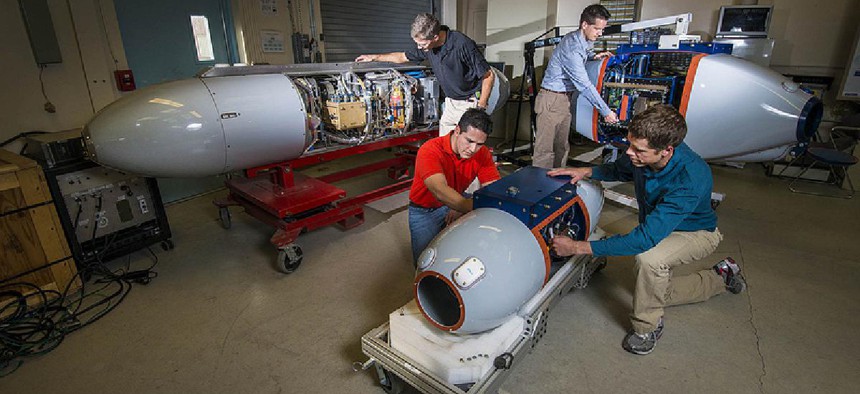Airborne nuclear forensics tool being prepared

Researchers prepare pods that, airborne, will track radiation to its source and identify nuclear bombs. Sandia National Laboratories
According to research, the technology would offer a “modular nuclear debris sampling capability."
The U.S. Air Force and a major national research laboratory are collaborating to deploy a new airborne tool for identifying the origin of a nuclear bomb after detonation.
The “Harvester” technology would offer a “modular nuclear debris sampling capability” -- pods that could be attached to manned or drone aircraft to collect and identify radioisotopes left behind by an atomic blast.
“Nuclear debris sampling and analysis enables verification that a nuclear explosive event occurred and aids in the national technical nuclear forensics mission requirements,” Susan Romano, spokeswoman for the Air Force Technical Applications Center, this week told Global Security Newswire. “Modularity can enable installation on a range of aircraft, potentially eliminating the need for payload-specific aircraft modifications.”
Nuclear forensics encompasses a range of technical capabilities to determine the start point for material in an atomic device that is seized in transit or actually detonated. That capacity is seen as a deterrent to rogue actors that might otherwise hope to get away with a nuclear attack, and as an asset for directing any U.S. response after an incident.
The U.S. ability to maintain a viable forensics infrastructure has been a point of concern in recent years. An expert panel convened by the National Academies warned in 2010 that “strong leadership, careful planning and additional funds” were needed to overcome troubles with present capabilities, which it said include the absence of a central leadership, insufficient personnel and outdated technology.
The Harvester system could also be a new resource for the Comprehensive Test Ban Treaty regime, which aims to prevent and identify illicit trial detonations that are seen as key to development of a nuclear arsenal, Romano stated by e-mail.
Research and development on the technology started around 2002, and design on the Harvester system dates to 2008 at the Sandia National Laboratories in New Mexico, officials said.
Initial flight-testing occurred in September at Grand Forks Air Force Base in North Dakota.
The system -- two pods for collecting and analyzing nuclear material and a third for guidance -- were placed on a Reaper drone owned by the Homeland Security Department’s Customs and Border Protection branch, Sandia said in a recent release.
The pods successfully gathered and analyzed various radioisotopes found in the atmosphere, suggesting they could do the same for material released by a manmade device.
Following an actual nuclear event, a drone could be directed to the “hot spot” of a post-explosion plume, Sandia said. Radioactive material would adhere to filter paper as the pods are flown through the affected area and then undergo sensor analysis to determine the specific kind and quantity of substance. Further study would be conducted once the filters are collected after the aircraft returns to base.
Sandia is also continuing work on a new Whole Air Sampling Pod, which could be used to gather gas samples at large volume rather than the particles collected by existing pods.
“The gas samples can then be analyzed for gas species of interest for forensics/treaty monitoring, notably short-lived radioxenon produced from a nuclear explosion,” Sandia project chief Joe Sanders stated by e-mail on Thursday.
The Pentagon hopes to try out the Harvester system on a manned aircraft this year, and to take over management of the technology in 2014, Romano stated.
The number of units to be built remains under consideration, she said. Meanwhile, “Harvester product improvement opportunities are being identified for possible future implementation,” the spokeswoman added.
Romano did not release details of costs for the project to date, or anticipated expenses as the Harvester program moves forward.





